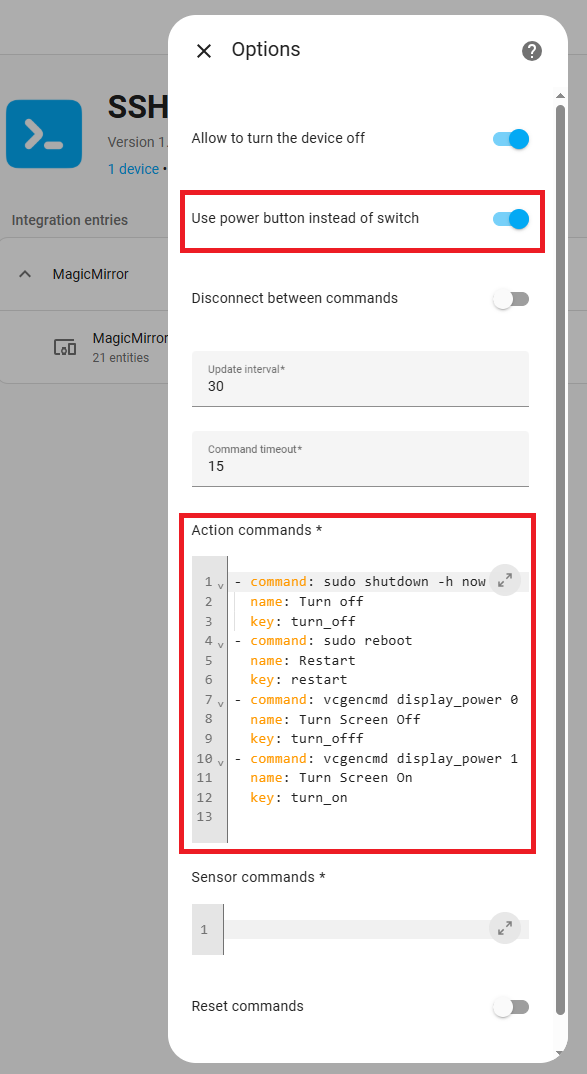It was a regular off the shelf mirror in a frame. I just removed the actual mirror portion from the frame and replaced it with 4mm tinted glass.
Read the statement by Michael Teeuw here.
Posts
-
RE: Home Dashboard
-
RE: Is adding Home Assistant the right way to go?
You can also try placing it bottom right and sizing by pixel count, increasing gradually until you reach your monitors full(ish) resolution
I haven’t tried full screen. But one of my configs looks like this :
{ module: "iFrame", position: "bottom_right", header: "HOUSE STATISTICS", config: { url: "http://192.168.1.4:8123/mm-dash-right", width: "410px", height: "215px" } },If I increase width, the iframe expands to the left. If I increase height, it expands up. Worth a shot.
-
RE: Is adding Home Assistant the right way to go?
Try the following :
In your HA configuration.yaml file, include the following
http: use_x_frame_options: falseRestart HA first, wait for it to finish, then restart your MM instance to see if the iFrame shows.
If not, give this this older MM module a shot. It’s more straight forward than iFrame Ping and it works with custom button cards ( i use them in my notification area ).
Within HA, you can also make use of the Kiosk Mode HACS add-on to hide the header and/or sidebars. Once installed, you simply add the following at the top of your dashboard YAML using the Raw configuration editor ( this step is shown in the vid ).
kiosk_mode: non_admin_settings: kiosk: true ignore_entity_settings: true -
RE: Is adding Home Assistant the right way to go?
I too use HA in a container on Synology. I make the dashboards within HA and use iFrame’s to display them on the MagicMirror. This way you can make the dashboards as pretty as you like. You really don’t have limits.
To get some idea :
https://forum.magicmirror.builders/topic/19738/home-dashboard?page=1
Initially I was running an older version of MagicMirror and I had to add the following in the configuration.yaml file of Home Assistant to have them to display :
http: use_x_frame_options: falseTo be fair, I haven’t tried excluding this since I rebuilt the MagicMirror using the latest build at the time. But it’s still in there today and isn’t causing any harm. It was more a HA workaround in any case
-
RE: Switching the Magic Mirror display on/off
Many thanks for the input. I’ll have a tinker when I find a gap and explore the commands and their respective soft switches. Just so that I’m future proof !
-
RE: Switching the Magic Mirror display on/off
Thanks for the heads up Sam.
I’m currently running Bullseye with kernel 6.1.21-v7+ and it still works in this revision. Admittedly I didn’t try with Bookworm as when I originally tried it ( Bookworm ) at launch, the VNC server had gone away on account of Wayland and alternatives were…interesting back then ( didn’t do too much research at the time to be fair ). So for this rebuild I just stuck with Bullseye.
2 quick questions for my own edification :
-
For Bookworm. Could the commands I listed for vcgencmd simply be replaced with wlr-randr --output HDMI-A-1 --on and wlr-randr --output HDMI-A-1 --off ( assuming HDMI port 1 ) for the same result ?
-
Another option according the the almighty but not always correct ChatGPT is to switch to X11 and then vcgencmd would work as expected ?
I have a spare Pi I could test on. I won’t however have time to tinker in the next few weeks. Curse having to adult !!
Really appreciate your input
-
-
RE: Switching the Magic Mirror display on/off
What you’re describing in Home Assistant sounds like a switch, not a button. They have different behaviours. This is important for what follows.
Initially I had our mirror turning on/off on a schedule using crontab. But when I rebuilt it recently, I too wanted some Home Assistant integration to make this a little more intelligent ( turn on/off with the alarm system for e.g. )
I went a different route and installed an SSH integration in Home Assistant ( there are enough modules on the long suffering Pi 3B+ ! )
Using this integration, any SSH command can be turned into button like so :

If you’re using a Pi, you can use the following in the configuration options of the integration :

The actual code for your ease of use :
- command: sudo shutdown -h now name: Turn off key: turn_off - command: sudo reboot name: Restart key: restart - command: vcgencmd display_power 0 name: Turn Screen Off key: turn_offf - command: vcgencmd display_power 1 name: Turn Screen On key: turn_onThat vcgencmd display_power command should work on pretty much an HDMI monitor
This results in a bunch of buttons that you can use in your Home Assistant automations

-
RE: Home Dashboard
Howdy !
Initially I looked into real 1-way mirror. But it was just too expensive for the size that I needed in our fair country.
So ! First I tried the DIY route. Picked up some 4mm glass, found some mirror tint film online and gave it a bash ! That film promptly ended up in a ball in the bin :S. It’s clear ( vicious pun ) that I’m handy with woodwork but suck at tinting.
I then took my sheet of glass to a car window tint business and they did a great job. I ended up going with the most reflective film they had as one step down just looked milky. Sadly that business is no longer in operation. But any car tint spot should do.
-
RE: Home Dashboard
@seabass Thank you !
I used an old Samsung BX2031.
The secret sauce here is that this particular monitor uses an external AC adapter / power brick. That’s how I could keep everything so thin. The AC adapter sits in the cupboard with the Pi . I simply extended the barrel jack side to reach the monitor through the conduit.
For video signal, I used a DVI to HDMI converter ( similar to pic below ) on the monitor side , and a 5m HDMI cable back to the Pi.
To make space for the power and video connectors, I recessed a wall box ( like those used for your bog standard light switch ) at the end of the cable conduit and lined it all up. So said connectors actually poke back into the wall a fair bit. But the wall box hides that nicely.

-
RE: Error in the calendar module check logs for more details
I put it here in config.js
module: "calendar", header: "Our Calendar", position: "bottom_right", config: { mmFetchTimeout: 60000, calendars: [